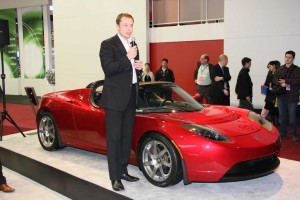
"The goal" of the partnership "is the expand the electric vehicle revolution," explained Tesla Motors founder Elon Musk. Daimler AG will take a 10% stake in his Silicon Valley battery car start-up.
Old world meets new, and in more ways than one with Daimler AG announcing it has purchased a 10% stake in the Silicon Valley start-up, Tesla Motors.
The two companies announced a more limited alliance, in January, when Tesla revealed it would assist the German luxury manufacturer develop its second-generation Smart ElectricDrive, or Smart ED. During a joint news conference in Stuttgart, this morning, Daimler Board Member Thomas Weber announced a limited fleet of battery-powered Smart fortwo cars will go into production late this year, with “series,” or commercial, production set for 2012.
“The goal of Tesla is to expand the electric vehicle revolution and with the partnership with Daimler, we can do this,” declared Elon Musk, the Internet pioneer who founded Tesla, and who has become one of the globe’s most vocal proponents of battery car technology.
While officials from the two companies decline to provide specific details, Weber hinted Daimler’s stake in Tesla cost it “in the double-digit (million) dollar sum,” and added that, “there are future options,” which he also declined to disclose. As part of the collaboration, Prof. Herbert Kohler, the Daimler Vice President in charge of E-Drive and Future Mobility, will take a seat on Tesla’s board of directors.
 The investment is critical to Tesla, which insiders say has been hammered by higher-than-anticipated costs for the development of its Roadster, its first production vehicle. The two-seat sports car ran into serious problems with its original, two-speed transmission design, which ultimately forced Tesla to settle for a single-speed gearbox. Now, it is rushing to develop a more mass-market midsize sedan, dubbed Model S, and Daimler could prove critical to that program.
The investment is critical to Tesla, which insiders say has been hammered by higher-than-anticipated costs for the development of its Roadster, its first production vehicle. The two-seat sports car ran into serious problems with its original, two-speed transmission design, which ultimately forced Tesla to settle for a single-speed gearbox. Now, it is rushing to develop a more mass-market midsize sedan, dubbed Model S, and Daimler could prove critical to that program.
With what he describes as a “great partnership,” Musk noted Tesla will provide its expertise with electric powertrain technology, while Daimler will bring to the relationship its more traditional product development skills, in areas like design and safety. Meanwhile, Weber praised his California partners for their dexterity in using non-traditional concepts and in bringing ideas to fruition much faster than has normally been the case in the slow and staid automotive world.
“First and foremost,” said Weber, working with Tesla should, “speed up the processes that bring an electrified vehicle to the market.”
With the Smart ED, Daimler will rely, at least initially, on the battery packs currently being used in the Roadster. Each pack uses cylindrical Lithium Ion, or LIon, cells like those commonly found in consumer electronics. Going forward, Daimler may turn to its own battery arm, Deutsche Accumotive GmbH, for more advanced LIon technology, and could provide its packs to Tesla, as well, for future products like the Model S.
Noting he is “battery agnostic,” Musk said that, “Among others the lithium-ion pouch-cell battery developed by Daimler and especially designed for automotive applications is of interest to us.”
Facing growing pressure to reduce emissions and increase fuel efficiency, Daimler is focusing much of its “electrification” efforts on its flagship Mercedes-Benz brand. At this year’s North American International Auto Show, in Detroit, it unveiled the Concept BlueZero E-Cell, a prototype battery car that signals what could come to market in the next decade. Mercedes is just launching its first hybrid-electric vehicle, a version of its ML sport-utility vehicle, and hopes to have its first pure battery-electric vehicle, or BEV, in showrooms sometime in 2010.
The race to bring battery power to market is rapidly charging up. Click here to read about TheDetroitBureau’s drive in a Chevrolet Volt prototype.
The Obama Administration’s new rules on Fuel Economy and Automotive Emissions will increase pressure on automakers to go electric. Click here for more on that story.
